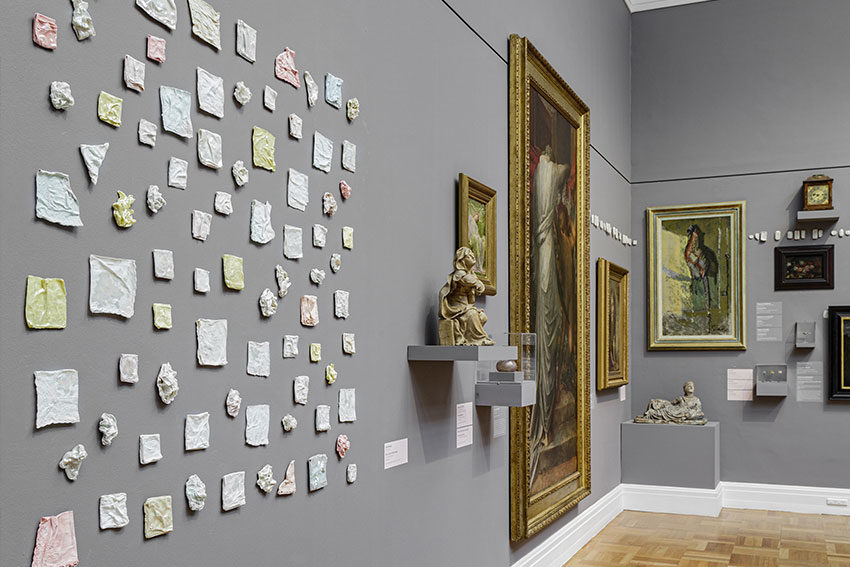Honor Freeman: grief and handkerchiefs

In Honor Freeman’s Ghost Objects, a series of seemingly mundane objects take on a quiet power through being delicately cast in ceramic.
In the days following the death of her father, Honor Freeman’s mother gave her his handkerchiefs, perhaps foreseeing that the small, worn squares of fabric might lead her daughter – an artist who makes ceramic impressions of seemingly mundane objects – towards contemplating the loss through in her studio.
“I remember writing stories as a child about toothbrushes going off and having adventures,” says Freeman, who still makes sense of life through work that observes and elevates objects that inhabit the everyday.
Freeman’s detailed ceramic impressions of cracked soaps, crisp sun-baked towels, food containers, bathplugs and power switches read as quiet, reverberating metaphors concerned with time and memory.
Take the soaps – objects that, in their usual place and function, are frequently used but rarely observed. Freeman, by contrast, has spent countless hours in her studio with eroded, splintered soaps, recasting them into strange shadow objects that beg to be seen.
On one hand, the soaps are literal imprints of the effects of time on a thing once new and complete. Freeman has recently started filling in the fractures running through the soaps, mirroring the Japanese art of Kintsugi in which broken pottery is repaired using a lacquer dusted in fine gold and, through the process of being broken and repaired, rendered more precious.

Over the last decade or so, Freeman has been gaining recognition as her work frequents Australian art fairs and group exhibitions. Her ceramics can be found in major private and public collections around the country including the collection at the National Gallery of Victoria. This year has been the biggest of her career so far, with a major installation at Hobart’s Australian Ceramics Triennale in May, and Ghost Objects, an exhibition created during a year-long artist-in-residence, showing at the Art Gallery of South Australia until September 29.
In Ghost Objects, Freeman explores new depths with a series of works she made during the months following her father’s death.
“Someone’s life comes to an end and all that’s physically left are their things,” she says.
“There is something touching and heartbreaking, really, in the objects we leave behind.
“I have been calling the things I make ‘ghost objects’ for a long time, because that’s how I see them – as an impression and not the thing itself. But with this exhibition those words took on new meaning.”
As she grieved, Freeman began seeking artworks in the gallery’s collection that circled around the intangible theme of grief – both broadly and in ways that hit on her own sense of loss. Back in the studio, her mind was on her dad’s handkerchiefs as she began an artwork that would require many more.

“I foolishly thought I could go to the second-hand store and start buying loads of used hankies, but of course, they don’t sell the used ones and it was really important to me that the hankies had been used.
“So, I put a call out asking strangers to send me their old hankies.”
Many responded, some enclosing personal notes with details of their object’s significance. Freeman began casting the handkerchiefs in porcelain by covering them in a clay slip and shaping them with her hands – neatly folding some and crumpling others. In scorching heat of the kiln, the fabric of the handkerchiefs burned away leaving behind a ceramic impression, a petrification, of what was.
The handkerchiefs – including a couple of the precious ones that belonged to her dad – are displayed in Ghost Objects in a large, sculptural collage surrounded by works in the collection (big or small, imposing or quiet) that relate to grief and loss. In the centre of the room, another work, All the tears I cried, conveys the physical mass of her grief through a series of porcelain buckets brimming with incandescent glaze. Along the upper edge of the gallery display, the Kintsugi soaps form a frieze interspersed with objects such as, at one point, the sorrowful eyes of a woman caught in a fragment of 2nd-3rd century AD funerary mosaic from the Parthian Empire. Within the context of works from throughout the ages, Freeman’s personal grief becomes just another beat in the endless rhythm of life and death.
“As an artist, I’m interested in telling the stories that have always been told,” she says, “and I’m interested in what happens to these objects, how the stories continue, when I let go of them.”
Among other things, Ghost Objects is a tender gathering of the stories people use to guide them through the landscape of grief. Religious and spiritual figures such as Mary in her role as Our Lady of Sorrows loom large in the exhibition. So do the smaller compasses we use – belongings that persist in the face of their owner’s absence, much-treasured jewels or keepsakes. Some attempt to place their personal loss within the long canon of art and literature on the subject. Many have added their own buckets of tears to the vast salty sea captured by the humble handkerchief.
Honor Freeman: Ghost objects
Art Gallery of South Australia
Until 27 September
agsa.sa.gov.au
Header image:
Installation view featuring Honor Freeman: Ghost Objects for The Collections Project 2019 presented in collaboration with Guildhouse, Art Gallery of South Australia, Adelaide (Photo: Saul Steed)